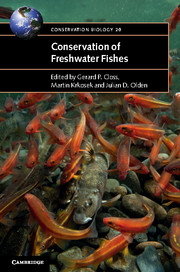Book contents
- Frontmatter
- Contents
- List of contributors
- Preface
- 1 Lost fishes, who is counting? The extent of the threat to freshwater fish biodiversity
- 2 Why are freshwater fish so threatened?
- 3 Climate change effects on freshwater fishes, conservation and management
- 4 Challenges and opportunities for fish conservation in dam-impacted waters
- 5 Chemical pollution
- 6 Multiple stressor effects on freshwater fish: a review and meta-analysis
- 7 Infectious disease and the conservation of freshwater fish
- 8 Non-indigenous fishes and their role in freshwater fish imperilment
- 9 Riparian management and the conservation of stream ecosystems and fishes
- 10 Fragmentation, connectivity and fish species persistence in freshwater ecosystems
- 11 Conservation of migratory fishes in freshwater ecosystems
- 12 Protecting apex predators
- 13 Artificial propagation of freshwater fishes: benefits and risks to recipient ecosystems from stocking, translocation and re-introduction
- 14 Freshwater conservation planning
- 15 Sustainable inland fisheries – perspectives from the recreational, commercial and subsistence sectors from around the globe
- 16 Understanding and conserving genetic diversity in a world dominated by alien introductions and native transfers: the case study of primary and peripheral freshwater fishes in southern Europe
- 17 Maintaining taxonomic skills; the decline of taxonomy – a threat to fish conservation
- 18 Synthesis – what is the future of freshwater fishes?
- Index
- References
3 - Climate change effects on freshwater fishes, conservation and management
Published online by Cambridge University Press: 05 December 2015
- Frontmatter
- Contents
- List of contributors
- Preface
- 1 Lost fishes, who is counting? The extent of the threat to freshwater fish biodiversity
- 2 Why are freshwater fish so threatened?
- 3 Climate change effects on freshwater fishes, conservation and management
- 4 Challenges and opportunities for fish conservation in dam-impacted waters
- 5 Chemical pollution
- 6 Multiple stressor effects on freshwater fish: a review and meta-analysis
- 7 Infectious disease and the conservation of freshwater fish
- 8 Non-indigenous fishes and their role in freshwater fish imperilment
- 9 Riparian management and the conservation of stream ecosystems and fishes
- 10 Fragmentation, connectivity and fish species persistence in freshwater ecosystems
- 11 Conservation of migratory fishes in freshwater ecosystems
- 12 Protecting apex predators
- 13 Artificial propagation of freshwater fishes: benefits and risks to recipient ecosystems from stocking, translocation and re-introduction
- 14 Freshwater conservation planning
- 15 Sustainable inland fisheries – perspectives from the recreational, commercial and subsistence sectors from around the globe
- 16 Understanding and conserving genetic diversity in a world dominated by alien introductions and native transfers: the case study of primary and peripheral freshwater fishes in southern Europe
- 17 Maintaining taxonomic skills; the decline of taxonomy – a threat to fish conservation
- 18 Synthesis – what is the future of freshwater fishes?
- Index
- References
Summary
INTRODUCTION
Fresh waters harbour exceptional levels of biodiversity (Chapter 1). However, various anthropogenic environmental forces threaten this splendid richness (Carpenter et al., 1992; Dudgeon et al., 2006; Strayer & Dudgeon, 2010; Chapter 2). These threats include invasive species (Rahel & Olden, 2008; Chapter 8), land-use changes (Allan, 2004), decreased connectivity (Jackson et al., 2001; Chapter 10) and various changes to water quantity and quality (Malmqvist & Rundle, 2002; Chapters 4–6). Furthermore, global climate change has been increasingly recognised as a pressing environmental change affecting many other stressors as well as having direct effects on fish diversity (Tonn, 1990; Comte et al., 2013). Climate change affects fish individuals, populations, species and communities at various spatial and temporal scales (Tonn, 1990; Carpenter et al., 1992; Graham & Harrod, 2009), ranging from effects on the behaviour of fish at a local scale to species distributions at biogeographic scales (Chu et al., 2005; Hickling et al., 2006; Ficke et al., 2007; Hein et al., 2011; Markovic et al., 2012).
Although climates have changed throughout the history of the Earth, the current rates of increases in temperature, changes in rainfall and occurrence of exceptional weather conditions are unprecedented (IPCC, 2007). For example, global annual average air temperatures are, depending on a climate change scenario, projected to increase from 1°C to 5°C by the end of this century, with much among-region variation. Highest changes in temperature have been seen and are likely to be recorded at high latitudes (IPCC, 2007), where the effects of increased water temperature on fish are also likely to be most profound (Lehtonen, 1996; Chu et al., 2005; Sharma et al., 2007; Heino et al., 2009). By contrast, closer to the equator, changes in temperature are not likely to be that pronounced, but changes in rainfall, decreases in river discharge and increases in human water withdrawal are likely to increase in the future (Xenopoulos et al., 2005; Thieme et al., 2010). Such changes suggest that there may be more irregular droughts and floods, which affect fish at various levels of organisation from individual physiology and population abundance to community structure and range shifts (Graham & Harrod, 2009; Morrongiello et al., 2011). Predicting the effects of climate change on the abundance and distribution of fish is thus highly challenging and regionally variable, but important for the conservation of fish diversity (Cochrane et al., 2009; Comte et al., 2013).
- Type
- Chapter
- Information
- Conservation of Freshwater Fishes , pp. 76 - 106Publisher: Cambridge University PressPrint publication year: 2015
References
- 11
- Cited by



